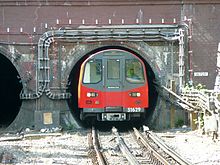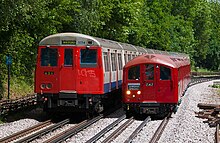Tubular track

A tube railway is a track-bound, mostly inner-city means of transport that runs in a tunnel built using shield driving , or corresponding tunnel sections. The term is particularly useful for certain lines of the London Underground in use, where between tube ( Tube lines ) and subsurface traces ( sub-surface lines is) distinguished.
history
The world's first underground railway ran in the British capital, London. On 10 January 1863, the first section was Metropolitan Railway , as an underground, nor with steam locomotives traffic, railway opened. The line was built as an under-paving railway, as part of the Metropolitan Line , it represents the nucleus of today's network.
The invention of the shield tunneling method made it possible to put the Thames Tunnel , still with a rectangular cross-section, into operation in 1843 . The first tunnel to be built with a round heading plate was built in 1869/1870. On August 2, 1870, also crossing under the Thames , the Tower Subway opened the world's first tube railway as a cable car . A carriage pulled by two stationary steam engines on a steel cable shuttled between the two banks through the single-track tunnel. Rail operations ended after four months.
The need for oxygen as well as the smoke and steam generated by the locomotives initially made it impossible to run trains at greater depths. Trains were only electrically powered from the end of the 19th century. The City and South London Railway took advantage of this development and opened a route from Stockwell to King William Street , again connecting the banks of the Thames . This section, now served by the Northern Line, is considered to be the oldest underground railway in the world built in deep, drilled tubes.
In 1898, the short Waterloo & City Line opened a second tube railway, followed by four more between 1900 and 1907. A characteristic of the London tube railways is the smaller clearance profile compared to the paving stones.
The low-lying sections of the underground in Glasgow , Scotland , which was initially put into operation as an underground cableway in 1896 , were also built using the shield tunneling method.
On the European mainland, the construction of tube railways could not initially prevail. Attempts by the AEG to establish a tube railway network in Berlin failed in the 1890s. For demonstration purposes, a tunnel was bored under the Spree , which was used by the tram from 1899 . For Métro Paris , the " Société du chemin de fer électrique souterrain Nord-Sud de Paris " (North-South) was considering the construction of tube railways, while the competing "Compagnie du chemin de fer métropolitain de Paris" (CMP) created elevated railways and paved roads .
Current
In the last few decades, many new subways were built, the routes of which were created using different construction methods. Even were, especially in New York , High railway lines placed underground. In Hamburg, the first section of the route was built between the Steinstraße and Hauptbahnhof stations using shield driving at the end of the 1950s . In Berlin, a shield tunneling section was created for the first time in the 1960s between the Möckernbrücke and Kleistpark stations .
As before, a distinction is made in London between tube and sub-pavement railways, with lines from both systems also operating outside tunnels. Among the Tube lines including the Bakerloo , Central , Jubilee , Northern , Piccadilly , Victoria and Waterloo & City line .
Other tube tracks
Nowadays, railway tunnels are often built using the shield tunneling method, but the term tube railway is not in use here. On the other hand, the term tunnel tube is often used if it was created by other construction methods and does not have a round cross-section. But mountain railways that run largely or entirely in tunnels, such as the former Kaprun 2 glacier lift, are hardly ever referred to as tube railways .
literature
- Johannes Bousset: The Berlin U-Bahn , published by Wilhelm Ernst & Sohn, Berlin 1935
- John R. Day: The story of London's Underground , London Transport Publicity Office, London 1979, ISBN 0-85329-094-6
- John Glover: London's Underground. The World's Premier Underground System , 9th Edition, Ian Allan Publishing, London 1999, ISBN 0-7110-2636-X
- Ulrich Lemke, Uwe Poppel: Berliner U-Bahn , 3rd edition, Alba-Verlag, Düsseldorf 1992, ISBN 3-87094-346-7
- Robert Schwandl: Metros in Britain , 1st edition, Robert Schwandl Verlag, Berlin 2006
- Jean Tricoire: Un siècle de métro en 14 lignes. De Bienvenüe à Météor , La Vie du Rail, Paris 2004, ISBN 2-902808-87-9
- George Watson: Glasgow Subway Album , Adam Gordon, Chetwode 2000, ISBN 1-874422-31-1
